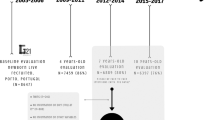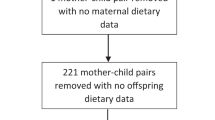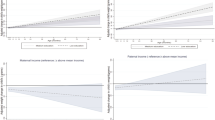Abstract
Background/Objectives:
Little is currently known about the relationship between the parental diet during pregnancy and the growth of the child from early childhood until early adulthood. This study was designed to examine whether the dietary patterns of the parents during a pregnancy and of the respective child at 3 years are associated with the length/height-for-age z-score of child at birth, 3 years of age and at 19 years of age.
Subjects/Methods:
Dietary patterns of pregnant women and their partners, and offspring at 3 years that were enroled in the 1990–1991 period in the Czech part of the European Longitudinal Study of Pregnancy and Childhood. Multivariable linear regression models were used to estimate the relationship between the dietary patterns of parents (835 child–mother–father trios) during pregnancy and the length/height-for-age z-score of their offspring at birth, 3 years and 19 years.
Results:
The maternal health-conscious food pattern was found to predict lower child height at 3 years, but not at birth nor at 19 years of age. An increase in the health-conscious pattern score of the maternal diet was associated with significantly lower height-for-age z-score at 3 years; however, the observed effect lost its significance after the adjustment for diet of the child at 3 years.
Conclusions:
After full adjustment, the only significant predictors of the height-for-age z-score of the child at 3 years were the heights of both parents and maternal education. More research into the association of maternal diet in pregnancy and height of child is necessary.
This is a preview of subscription content, access via your institution
Access options
Subscribe to this journal
Receive 12 print issues and online access
$259.00 per year
only $21.58 per issue
Buy this article
- Purchase on Springer Link
- Instant access to full article PDF
Prices may be subject to local taxes which are calculated during checkout
Similar content being viewed by others
References
Schmidt M, Bøtker HE, Pedersen L, Sørensen HT . Adult height and risk of ischemic heart disease, atrial fibrillation, stroke, venous thromboembolism, and premature death: a population based 36-year follow-up study. Eur J Epidemiol 2014; 29: 111–118.
Samaras TT, Elrick H . Height, body size and longevity. Acta Med Okayama 1999; 53: 149–169.
Emerging Risk Factors Collaboration. Adult height and the risk of cause-specific death and vascular morbidity in 1 million people: individual participant meta-analysis. Int J Epidemiol 2012; 41: 1419–1433.
Shimizu Y, Nakazato M, Sekita T, Kadota K, Arima K, Yamasaki H et al. Relationship between adult height and body weight and risk of carotid atherosclerosis assessed in terms of carotid intima-media thickness: the Nagasaki Islands study. J Physiol Anthropol 2013; 32: 19.
Eide MG, Øyen N, Skjaerven R, Nilsen ST, Bjerkedal T, Tell GS . Size at birth and gestational age as predictors of adult height and weight. Epidemiol Camb Mass 2005; 16: 175–181.
Ceesay SM, Prentice AM, Cole TJ, Foord F, Weaver LT, Poskitt EM et al. Effects on birth weight and perinatal mortality of maternal dietary supplements in rural Gambia: 5 year randomised controlled trial. BMJ 1997; 315: 786–790.
Osrin D, Vaidya A, Shrestha Y, Baniya RB, Manandhar DS, Adhikari RK et al. Effects of antenatal multiple micronutrient supplementation on birthweight and gestational duration in Nepal: double-blind, randomised controlled trial. Lancet 2005; 365: 955–962.
Leary S, Ness A, Emmett P, Davey Smith G . ALSPAC Study Team. Maternal diet in pregnancy and offspring height, sitting height, and leg length. J Epidemiol Community Health 2005; 59: 467–472.
Northstone K, Emmett PM . Are dietary patterns stable throughout early and mid-childhood? A birth cohort study. Br J Nutr 2008; 100: 1069–1076.
Hu FB . Dietary pattern analysis: a new direction in nutritional epidemiology. Curr Opin Lipidol 2002; 13: 3–9.
Godfrey K, Robinson S . Maternal nutrition, placental growth and fetal programming. Proc Nutr Soc 1998; 57: 105–111.
Zhu Y, Olsen SF, Mendola P, Yeung EH, Vaag A, Bowers K et al. Growth and obesity through the first 7 y of life in association with levels of maternal glycemia during pregnancy: a prospective cohort study. Am J Clin Nutr 2016; 103: 794–800.
European longitudinal study of pregnancy and childhood (ELSPAC). Paediatr Perinat Epidemiol 1989; 3: 460–469.
Golding J, Pembrey M, Jones R, ALSPAC Study Team. ALSPAC—the Avon Longitudinal Study of Parents and Children. I. Study methodology. Paediatr Perinat Epidemiol 2001; 15: 74–87.
Boylan S, Welch A, Pikhart H, Malyutina S, Pajak A, Kubinova R et al. Dietary habits in three Central and Eastern European countries: the HAPIEE study. BMC Public Health 2009; 9: 439.
Dofkova M, Kopriva V, Resova D, Rehurkova I, Ruprich J . The development of food consumption in the Czech Republic after 1989. Public Health Nutr 2001; 4: 999–1003.
Hair Jr JF, Anderson RE, Tatham RL, Black WC . Multivariate Data Analysis. Prentice-Hall, Inc.: Upper Saddle River, NJ, USA, 1995.
Mardia KV, Kent JT, Bibby JM . Multivariate Analysis. Academic Press: London, New York, 1979.
Royston P, White IR . Multiple Imputation by Chained Equations (MICE): Implementation in Stata. J Stat Softw 2011; 45: 1–20.
R: A language and environment for statistical computing. R Foundation for Statistical Computing: Vienna, Austria.
STATA: Stata Statistical Software: Release 14. StataCorp LP: College Station, TX, USA.
Venkaiah K, Brahmam GNV, Vijayaraghavan K . Application of factor analysis to identify dietary patterns and use of factor scores to study their relationship with nutritional status of adult rural populations. J Health Popul Nutr 2011; 29: 327–338.
Vaz J, dos S, Kac G, Emmett P, Davis JM, Golding J et al. Dietary patterns, n-3 fatty acids intake from seafood and high levels of anxiety symptoms during pregnancy: findings from the Avon Longitudinal Study of Parents and Children. PloS One 2013; 8: e67671.
Kind KL, Moore VM, Davies MJ . Diet around conception and during pregnancy–effects on fetal and neonatal outcomes. Reprod Biomed Online 2006; 12: 532–541.
Wood-Bradley RJ, Henry SL, Vrselja A, Newman V, Armitage JA . Maternal dietary intake during pregnancy has longstanding consequences for the health of her offspring. Can J Physiol Pharmacol 2013; 91: 412–420.
Stein AD, Kahn HS, Rundle A, Zybert PA, van der Pal-de Bruin K, Lumey LH . Anthropometric measures in middle age after exposure to famine during gestation: evidence from the Dutch famine. Am J Clin Nutr 2007; 85: 869–876.
van den Broek M, Leermakers ET, Jaddoe VW, Steegers EA, Rivadeneira F, Raat H et al. Maternal dietary patterns during pregnancy and body composition of the child at age 6 y: the Generation R Study. Am J Clin Nutr 2015; 102: 873–880.
Switkowski KM, Jacques PF, Must A, Kleinman KP, Gillman MW, Oken E . Maternal protein intake during pregnancy and linear growth in the offspring. Am J Clin Nutr 2016; 104: 1128–1136.
Stanner SA, Bulmer K, Andrès C, Lantseva OE, Borodina V, Poteen VV et al. Does malnutrition in utero determine diabetes and coronary heart disease in adulthood? Results from the Leningrad siege study, a cross sectional study. BMJ 1997; 315: 1342–1348.
Crume TL, Brinton JT, Shapiro A, Kaar J, Glueck DH, Siega-Riz AM et al. Maternal dietary intake during pregnancy and offspring body composition: The Healthy Start Study. Am J Obstet Gynecol 215: 609.e1–609,e8.
Acknowledgements
We are grateful to Pavel Piler and Vit Kandrnal for valuable comments and assistance in cohort description. The ELSPAC study is currently supported by the RECETOX Research Infrastructure of Masaryk University CETOCOEN PLUS (CZ.02.1.01/0.0/0.0/15_003/0000469), the National Feasibility Programme of the Ministry of Education of the Czech Republic (LO1214) and by the CELSPAC: Central European Longitudinal Study of Pregnancy and Childhood (MUNI/M/1075/2013) support programme.
Author contributions
JBV was responsible for the design and interpretation of all study data, and drafted the manuscript. FZ was responsible for conducting the data analysis and interpretation of results. TP, JN, AP, OM, LA and PČ were responsible for the evaluation of the dietary data in the context of the early 90s in the Central Europe and contributed to manuscript preparation. JŠ was responsible for the appropriate data management and participated in the statistical analyses. HP supervised the analyses and critically revised the manuscript. All authors contributed to the intellectual content and approved the final version of the manuscript.
Author information
Authors and Affiliations
Corresponding author
Ethics declarations
Competing interests
The authors declare no conflict of interest.
Additional information
Supplementary Information accompanies this paper on European Journal of Clinical Nutrition website
Supplementary information
Rights and permissions
About this article
Cite this article
Bienertová-Vašků, J., Zlámal, F., Pruša, T. et al. Parental heights and maternal education as predictors of length/height of children at birth, age 3 and 19 years, independently on diet: the ELSPAC study. Eur J Clin Nutr 71, 1193–1199 (2017). https://doi.org/10.1038/ejcn.2016.244
Received:
Revised:
Accepted:
Published:
Issue Date:
DOI: https://doi.org/10.1038/ejcn.2016.244



